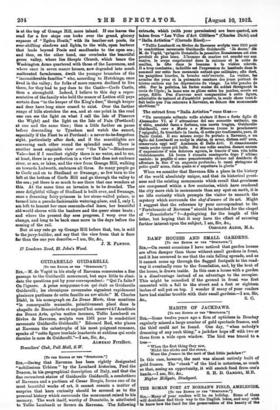[To THE EDITOR OP THE "SPECTATOR. "] SIR, — Seeing that Ravenna has
been rightly designated "nobilissima 1Jrbium " by the Lombard historian, Paul the Deacon, in his geographical description of Italy, and that the fine recumbent statue of Guidarello Guidarelli, a condottiero of Ravenna and a partisan of Caesar Borgia, forms one of its most beautiful works of art, it cannot remain a matter of surprise that keen curiosity should be aroused as to the personal history which surrounds the monument raised to his memory. The work itself, worthy of Donatello, is attributed to Tullio Lombardi or Severo da Ravenna. The following extracts, -which (with your permission) are here quoted, are taken from " Les Villes d'Art Celebres" (Charles Diehl) and "Italia Artistica" (Corrado Ricci):— " Tullio Lombardi ou Severe de Ravenna eculpta vers 1501 pour le condottiere ravennate Guidarello Guidarelli. 'Jo doute,' dit M. do Vogue, `qu'apres Donatello In premiere Renaissance ait rien produit de plus beau. L'hommo de marbre est couche sur son suaive, le corps emprisonne dans in cuirasse et la cotta de mailles, in tete dans le heaume a la visiere relevee. fl a trop combatta ; indicible est l'expression de lassitude dans Is sommeil sur cette face monacale autant que militaire; elle dort, les paupieres lourdes, la bouche enteouverte. La visiere, les arcades des yeux et in puissante ossature des joues portent de tristes ombres stir les depressions du visage. La tete pencho de c6te. Sur In poitrine, les fortes mains du soldat etreignent In croix do l'epee; in lame nue se glisse entre les jambes, serree an corps, fidele. Peu d'muvres soot comparables 1 cetto figure, admirable de naturel et d'austerite pensive, la seule chose tout-it- fait belle que l'on retrouve I Ravenne, en dehors des monuments chretiens.'"
The extract from "Italia Artistica." runs thus :—
"Un ravennate soltanto voile aiutare it fiero e forte figlio di Alessandro VI. at 1' attuazione del sno concetto unitario, ma, n' ebbe, auricle fama e fortuna, una morte tragica, Guidarello Guidarelli, taro a Marte e a Minerva (come lo proclamavo 1' epigrafe), fu trucidato in Imola, di notte per tradimento, pare, di Paolo Orsini. Il suo misers' corpo fu portato a Ravenna, e un figlio del Lombardi ne scolpi in status, in arme, distesa sull' area, conservata oggi nell' Academia di Belle Arti. II rinascimento vanta poche opera piu belle. Nel sno yoke sembra durare ancora d' expressione d' una dolorosa agonies, le traccie d' una vita tolta violentemente. La bocca 6 rimasta semiaperta dope 1' ultimo rantolo : le pupilssi sone pesantemente chino nel desiderio di affretare in fine d' ttn angoscia profonda; le mani stringeno al
petto arma, dalla quale ei s' aspettava la glories"
When we consider that Ravenna fills a place in the history of the world absolutely unique, and that its historical great- ness and the existing monuments which recall that greatness are compassed within a few centuries, which have rendered the city more rich in monuments than any spot on earth, it is no idle curiosity which prompts the visitor to unearth the mystery which surrounds the chef-d'auvre of its art. Might I suggest that the reference by your correspondent to the "Fortebraccio of Ravenna" should be intended for the chapel of "Braccioforte" P—Apologizing for the length of this letter, but hoping that it may have the effect of arousing further interest upon the subject, I am, Sir, &c.,
OSBORNE ALDIS, M.A.


































 Previous page
Previous page